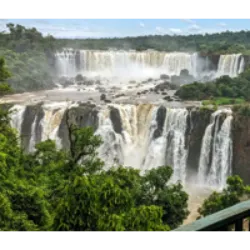The Casa Rosada, seat of the Argentine government

The Casa Rosada, the seat of the Argentine government, is one of the most emblematic buildings in Buenos Aires. Its history dates back to the 16th century, when the site housed a Spanish fort to protect the city. Over time, the building was renovated and, in the 19th century, under the government of Domingo Faustino Sarmiento, it acquired its iconic pink color, which symbolized the union between the Unitarians (white) and Federalists (red), rival political factions at the time.
Located in Plaza de Mayo, the Casa Rosada has been the scene of historic events, such as speeches by Juan and Eva Perón, as well as notable political demonstrations. Today, in addition to being the center of executive power, the site houses the Casa Rosada Museum, where you can see presidential objects, antique furniture and exhibits on Argentine history.
Visitors can take free guided tours of the historic rooms, the famous presidential balcony and explore the palace's rich architecture. An essential tour for anyone wanting to understand Argentine politics and culture.
Argentina is an incredible country for tourism, with a wide range of cultural

Argentina is an incredible country for tourism, with a wide range of cultural, historical and natural attractions. Here are some of the main tourist destinations in Argentina: Buenos Aires: the capital of Argentina, famous for its historic center, unique architecture, charming neighborhoods and lively nightlife. Mendoza: a wine region in the west of Argentina, with many wineries to visit and try world-famous Argentine wines. Bariloche: a city located in the lake region of southern Argentina, surrounded by mountains and pine forests. It is a popular destination for winter sports and summer hiking. Iguazu Falls: A series of spectacular waterfalls located on the border between Argentina and Brazil, surrounded by tropical rainforest. Ushuaia: the southernmost city in the world, located in Tierra del Fuego, in Argentine Patagonia. It's a popular destination for outdoor activities like skiing, hiking and boating.
Test yourself with one of these challenges 👇
Discover some interesting facts about Argentina Tourism
Puerto Madero, in Buenos Aires, is a central and valued neighborhood

Puerto Madero, in Buenos Aires, is a central and valued neighborhood, known for its revitalization in the 1990s. Former port area, named in honor of Eduardo Madero, stands out for its renowned architecture and is considered the most exclusive neighborhood in America Latin. Originating as a project for a new port in 1882, it became obsolete in the following decades, but re-emerged as a prominent district after the creation of Puerto Nuevo in the 1920s. A 2018 study named Puerto Madero as the most sought-after neighborhood and expensive in the region.
The Iguazu Falls, in Buenos Aires, Argentina

The Iguazu Falls, in Buenos Aires, Argentina, are an impressive cascade of two steps formed by three layers of basalt, with heights of 35 and 40 meters. Located in the Serra Geral formation, their configuration is controlled by the resistance of the vesicular basalt. The falls are divided by numerous islands, creating multiple drops 60 to 82 meters high over 2.7 kilometers. The Devil's Throat, 80-90 meters wide and 70-80 meters deep, stands out, absorbing half of the river's flow. The junction of water flows marks the border between Brazil, Argentina and Paraguay, a tourist attraction. The arrangement of the falls forms an inverted "J", with the Devil's Throat marking the border between Argentina and Brazil. The right bank belongs to Brazil, while the banks on the left are Argentine.
The Japanese Garden of Buenos Aires

The Japanese Garden of Buenos Aires, built in 1967 during the visit of the Crown Prince of Japan, is located in Parque Tres de Fevereiro, in Palermo. Managed by the Argentine-Japanese Cultural Foundation, the public space, although paid for, finances the maintenance of the Japanese Garden Cultural and Environmental Complex. The garden stands out for its harmony and balance, symbolized by bridges such as Puente de Dios and Puente Truncado. In addition to native trees and Japanese plants, the site has a lake with colorful carp and samurai-style figures.
The Perito Moreno glacier

The Perito Moreno glacier, located between 47º and 51º south latitude in Argentina, is an imposing mass of ice honoring Francisco Pascasio Moreno. Extending from the Southern Patagonian Ice Field to the southern arm of Lake Argentino, the glacier is five kilometers wide and 60 meters high. Considered one of the largest freshwater reserves in the world, it is in Los Glaciares National Park. The unique phenomenon of the glacier damming the lake's waters results in spectacular collapses at irregular intervals. Tourists can observe the event from a safe distance, and it is possible to walk on the glacier with guides. Discovered in 1879, it was initially called "Francisco Gormaz" and later "Bismarck". After territorial disputes, the 1899 treaty granted Argentine sovereignty, and the glacier was officially named Perito Moreno Glacier in honor of Francisco Moreno.
Nahuelito Park, in Argentine Patagonia, covers 71

Nahuelito Park, in Argentine Patagonia, covers 71,000 hectares on the banks of Lake Nahuel Huapi, known for its biodiversity and legends about the Nahuelito creature. In addition to stunning landscapes and outdoor activities, the park plays a vital role in nature conservation, protecting unique ecosystems and endangered species. Sustainable tourism promotes local employment and enhances natural heritage. Activities include hiking, boating and bird watching, with interpretation centers to learn about the park's history, geology and wildlife. Respecting regulations is crucial to preserving their delicate ecosystems.
Test yourself with one of these challenges 👇
HOME













